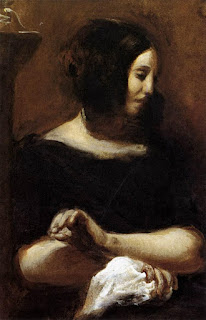Eugène Delacroix: Retrato de George Sand.
 Mediante la adopción del seudónimo masculino, algunas escritoras del siglo XIX y de la primera mitad del XX pudieron introducirse en un ámbito controlado absolutamente por hombres: el de la literatura. La sustitución de su nombre legal por otro ficticio les permitió ganarse el respeto de un elevado porcentaje de lectores que se mostraban todavía reticentes a valorar positivamente las obras escritas por una mujer, consideradas frívolas, sensibleras e intrascendentes. La necesidad de llevar puesta una máscara para alcanzar semejantes objetivos demuestra, no obstante, que las autoras de entonces en cierto modo seguían sometidas a los dictámenes de la sociedad patriarcal, cuyos prejuicios hubieron de asumir si querían que sus textos vieran la luz y fuesen tomados en serio.
Mediante la adopción del seudónimo masculino, algunas escritoras del siglo XIX y de la primera mitad del XX pudieron introducirse en un ámbito controlado absolutamente por hombres: el de la literatura. La sustitución de su nombre legal por otro ficticio les permitió ganarse el respeto de un elevado porcentaje de lectores que se mostraban todavía reticentes a valorar positivamente las obras escritas por una mujer, consideradas frívolas, sensibleras e intrascendentes. La necesidad de llevar puesta una máscara para alcanzar semejantes objetivos demuestra, no obstante, que las autoras de entonces en cierto modo seguían sometidas a los dictámenes de la sociedad patriarcal, cuyos prejuicios hubieron de asumir si querían que sus textos vieran la luz y fuesen tomados en serio.
Con el seudónimo varonil ‒unido ocasionalmente también al travestismo físico, como ejemplifica el caso de George Sand‒, las escritoras forjaron de sí mismas unas imágenes descentradas, ambiguas, andróginas. Al mismo tiempo, la estrategia del cambio de género autoral presuponía el reconocimiento de una «condición masculina» inherente a la escritura.
Abstract
By using male pseudonyms, some women writers in the 19th and first half of the 20th century were able to make their way into a territory controlled totally by men: literature. The replacement of their legal names by fictitious ones allowed them to gain the respect of a huge number of readers, who were still reluctant to value the texts written by women in a positive way: female literature was seen as frivolous, overemotional and trivial. Nevertheless, the need to wear a mask to attain such important goals proves that women were somehow subject to the dictum of the patriarchal society, the prejudices of which were to be taken into account if they really intended to publish their works and be given serious consideration.
With the male pseudonym –sometimes combined with physical transvestism, as shown by the case of George Sand–, women writers shaped off-centre, ambiguous and androgynous self-images. At the same time, the strategy of changing gender as authors implied the acknowledgement of a «masculine nature» that was inherent to literature.


